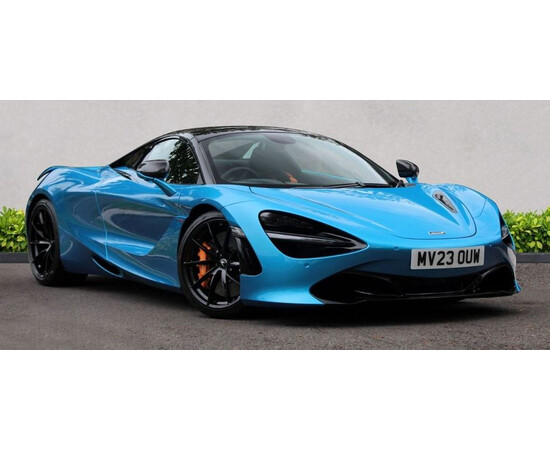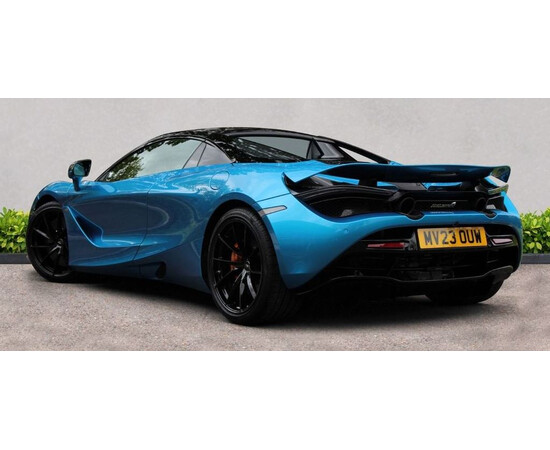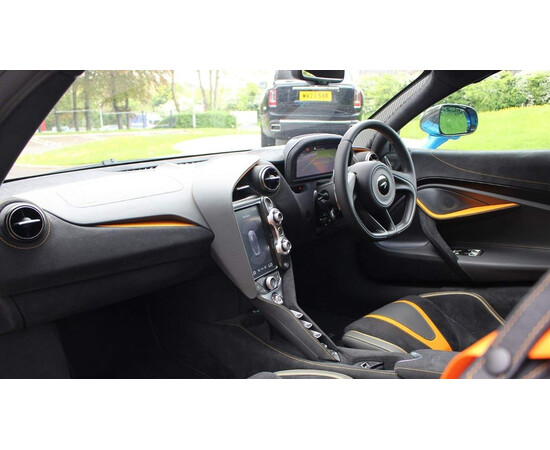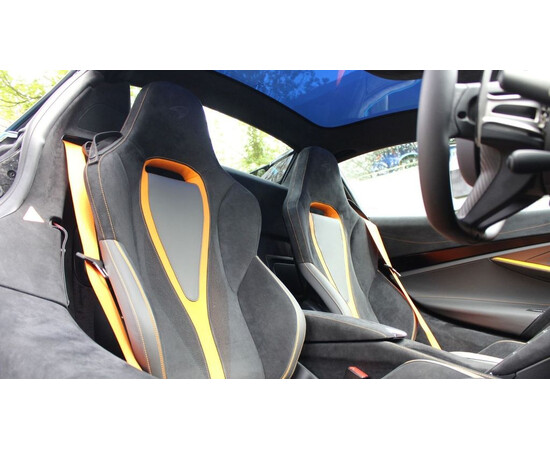- Список вариантов товара
| КОД | Origin Country | Colour | Доступность | Цена | ||
|---|---|---|---|---|---|---|

|
60823F34367EEUK
|
В наличии
|
13.741661 BTC | |||

|
60823F34367EEUK_B95C
|
В наличии
|
14.526673 BTC |

- — Гарантия 12 месяцев
- — Оповещение по SMS
- — Возврат и обмен
- — Различные способы оплаты
- — Лучшая цена
From a standing start less than a decade ago, McLaren has ridden out some early speed bumps and gone on to blow our collective minds with the likes of the 570S, 675LT, and P1. The 720S signals another major milestone: this is the first time McLaren has completely replaced one of its core cars.
Development work started back in 2013, before the 650S had even been announced, and a big chunk of it was done virtually. The first full validation car was only built and driven 11 months ago, so its path to market has been extremely rapid.
McLaren says 91 per cent of the 720S is new, and the enlarged 4.0-litre engine features 41 per cent new content: turbos, intercoolers, cast-aluminium plenum, cylinder heads, crankshaft, pistons, and exhaust. Topline numbers include 710bhp, 568 torques, 249 CO2s, 0-62mph in 2.9 seconds, 0-124mph in 7.8, and 0-186mph (300km/h, if you prefer) in 21.8. There’s also some seriously funky new software to go with the hard bits, and a handful of theatrical flourishes. The doors are double-skinned dihedral jobs that open to 80°, and the engine isn’t just visible through the rear screen, it’s also illuminated.
There’s also lots of carbon fibre. Dubbed ‘Monocage II’, the chassis structure now incorporates an upper structure and windscreen surround, so it’s even more rigid than the 650. Lighter, too: its lightest dry weight is 1283kg, 18kg less than the equivalent 650S. There’s an enhanced centre of gravity, thanks to the engine being mounted 150mm lower than before. A ‘visible monocage’ that exposes the material on the inside of the A-pillar is a £3990 option (more on all that later: things can get very costly indeed). The cowl is also lower: like the magnificent 570, the 720S gets closer to serving up the jet fighter sensation than anything else on the road, and its vision all-round is peerless. The all-glass cockpit isn’t just pretty, it means you can traverse London without mowing down a peloton of cyclists, or reverse park the thing without knackering your street cred. Or the alloys.
The aero work is off-the-scale: the panel ahead of the front wheels evacuates the turbulent high pressure air away and along the side to increase downforce, while a channel at the top of the doors ducts high velocity cooling air into the radiators in the engine bay. There are no bodywork slashes here, despite its mid-engined configuration. The 720S generates 50 per cent more downforce than the 650S managed at full tilt, has double the overall aerodynamic efficiency, and is 15 per cent more efficient in its cooling.
McLaren says it was targeting the excitement of the 675 LT and the refinement of the 570 GT, which are lofty and possibly incompatible goals. It’s also worth remembering that the 720S is pretty much P1-fast in certain increments, and has similar braking capability (from 124mph to standstill in 4.6 seconds across just 117m). Crazy stuff. But it’s also designed to be useable every day, accessible and non-threatening even to numpties, and emits a relatively cuddly 249 CO2s. On paper, it’s almost miraculous.
It’s certainly good. In fact, we’d go so far as to say this is probably the single most accomplished supercar we’ve ever driven, which is not the sort of statement we make lightly.
First impressions here are great: steering feel is impossible to measure objectively, but the 720S has that road/car/driver telepathic thing absolutely nailed – it moves like a big Lotus Elise. It’s monumentally fast, possesses the sort of high-speed balance and stability that bespeaks absolute mastery of aerodynamics, and somehow refuses to punish you even on truly execrable road surfaces.
Here’s the thing: the 720S is easy to drive. Really easy. Common sense demands acclimatisation, but you get settled incredibly quickly. Tyre noise and mechanical thrum is negligible at regular cruising speeds. Turn up the heat and the McLaren does that thing all sub-3.0 seconds to 60mph cars do: compress time. You are here, now you are there: the bit in between is simply vaporised. But rarely has the time-warp been performed with so little conspicuous drama. The twin turbos are ultra-low inertia, twin scroll jobs that spool up much faster to reduce lag and sharpen throttle response. The red line in first and second gear is 8100rpm, 8200 in the next four. Keep the throttle pinned throughout, and big numbers rack up very rapidly indeed. Shift times on the seven-speed dual-shift ’box are 45 per cent faster than even the 675 LT delivers. You can sense the chassis electronics doing their thing, but only just. The 720S’s limits are somewhere beyond sky-high and out in the stratosphere.
McLaren has reworked the harmonics on the new exhaust system too, and the optional Sports Exhaust (there goes another £4750) uses an intake sound generator to pump more volume into the cabin via twin vents mounted between the seats on the rear bulkhead. In standard form, the 720S is just five per cent off the 570GT in terms of noise levels, so it can do the long-haul; the sports exhaust moves it much closer to the 675 LT on the audio spectrum. Overall, and purely subjectively, we’d still say a normally aspirated engine has the edge – a shout out here to Audi’s brilliant and rather under-appreciated R8 – but as turbo motors go, the 720S is a new benchmark. Especially if you do what McLaren calls a ‘hot start’, which means sticking it in track/track mode, at which point it emits an entirely pointless but highly enjoyable wail.
On track, the 720S is so damned good it’s almost… undramatic. Dramatically undramatic. It’s that edgy supercar question again: do you need to be asking for planning permission on the ragged edge before decreeing something a ‘real’ supercar? Or do you just want to go ballistically fast, everywhere, rain or shine, with almost total impunity? The 720S isn’t clinical, but it is surgical. The new Variable Drift Control, which, according to McLaren, ‘delivers additional enjoyment in Sport and Track modes, with finger-tip control of Electronic Stability Control intensity’, is amusing, but you still need to be able to balance steering and throttle effectively, so why not just turn everything off? Goodwin reckons the system works like the nine-stage traction control in McLaren’s GT race cars, and the end game is finding the best set-up for whichever track you regularly visit. In other words, traction optimisation rather than control. Whatever your bag, turn all the electronics off and the sheer genius of the chassis is laid bare. What a machine this is.
The 720S somehow combines the brutal ergonomic efficacy of a race car with the technical luxury of a contemporary GT. The drive mode controls now live in a vertical pod to the left of the wheel. The principal read-outs are housed directly ahead, and the ‘folding display’ is very cool, the idea being that you can focus on the key read-outs if you’re in maximum attack mode.
The D, N and R buttons are in another pod that tapers towards the bottom. The doors eat into the roof, Ford GT40-style, and it really does feel like being at the pointy end of an arrow, only with much more control over your own destiny. The ‘human’ graphic on the climate control display is wearing a crash helmet. Nice touch.
There’s also an awesome 1280W audio system, and the speakers are a seamlessly integrated part of the interior topography. But the sat nav drove me mad, and the seat controls are difficult to reach (£2730 for heated electric seats btw). Turns out they’re one of the few things carried over from the 650S.
A small but important point: the three-spoke wheel isn’t buried under a welter of buttons, it exists to steer the car and nothing else. Proper.
On power alone it vaults itself ahead of its Ferrari rival, which might bring the new 488 Speciale (or whatever it’ll be called) onto the front-burner. The 720S is magnificent, but also surprisingly nuanced for such an adrenalised proposition. It takes time to work out the full scale of its, and its creators, achievements.
























